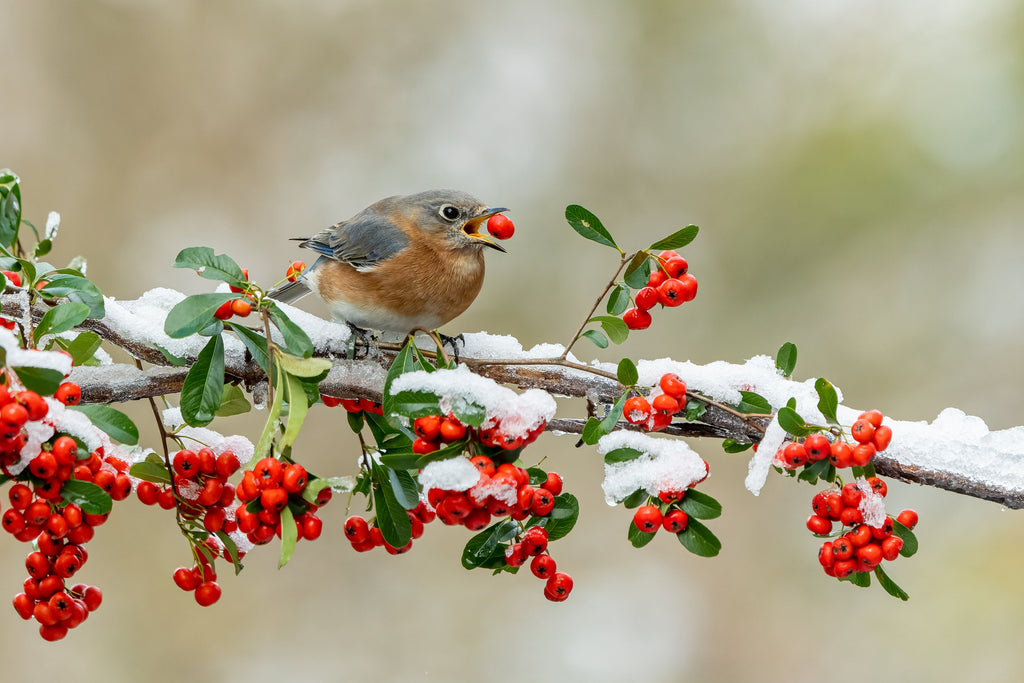We’re seeing record cold and snow, hurricane winds, and flooding rains—in other words, inside weather! So, who’s actually thinking about planting in the garden? Once again, ‘tis the season for pen, paper, and planning. Take advantage of this winter down time and begin thinking about how you want your garden to look (and what you’ll need to do when spring arrives).
As suburban sprawl continues to grow, the natural habitat of birds and small animals continues to shrink. However, homeowners can make landscaping choices to help protect wildlife.
Personally, I love that my yard is filled with beautiful birds that come and go with the seasons. When planning your yard, remember that birds need a place for nesting and hiding from predators. Wildlife can make your yard not only a special place for your family but also a learning lab for your children.
Planting conifers (evergreens) in a group provides a safe place for birds to nest their young. Instead of a yard full of grass, opt to plant:
- Hedges with low branches
- Shrubs
- Thorny plants
- Ground cover
These plants will add variety and create a safe habitat for birds.

Plants to Feed Local Wildlife
As I write this, I’m watching birds fight over the berries on my mahonia. Ecologically, mahonias are important to many bird species because they provide both food and protective nesting areas. But there are plenty of other plants that can serve as fall and winter food sources for animals, including:
- Crabapples
- Dogwoods
- Mountain ashes
- Hawthorns
Mahonias, like the one in my yard, make fine back-of-the-border focal points. Their foliage is bold and architectural, and most varieties tend to be upright in growth, spreading more as they mature. In late summer, autumn, and winter, the mahonia’s frost-hardy flowers appear. Some varieties bloom through winter until as late as March and feature an attractive fragrance that resembles Lily of the Valley. They’re also popular with winter bumblebees!

The Washington Hawthorn is a small tree (zones 4-8) that grows 25 to 30 feet with a 25-foot spread. It likes full sun and is loved by many songbirds. In early June, the hawthorn’s white flowers will appear. Then, you’ll begin seeing small red fruit that will remain on the tree into winter, providing food for birds and other small animals.
The American Mountain Ash (zones 2-5) is a small tree with dark green leaves that turn orange and purple in the fall. Its showy white spring flowers are followed by red fruit beloved by birds. It grows up to 30 feet tall and 15 feet wide in well-drained soil and full sun to light shade.
Dogwoods (zones 5-9) are another fine dining spot for our feathered friends. The Pink Dogwood grows up to 25 feet and prefers partial shade and well-drained soil. As the name implies, its spring flowers are pink, its winter bark is checkered with gray stems, and its berries are glossy red.

Alternatively, the Kousa Dogwood likes partial shade to full sun, and its white flowers appear in May and June. In the fall, the Kousa becomes a showpiece with foliage that turns bright purple and scarlet. The Red Dogwood also produces bright autumn colors like the Kousa. However, it prefers partial shade, and its blooms are—you guessed it—red.
Last but certainly not least, is the beautiful White Dogwood. It grows wild in many areas because birds spread its seeds throughout their natural habitats. As with most other dogwoods, this one likes partial shade and well-drained soil.
When in Doubt, Plant a Dogwood
You can’t go wrong when planting a dogwood tree. Its spring flowers and fall foliage will add stunning color and dimension to your landscape. And as far as the winged nation is concerned, a dogwood will provide ample food and shelter—just add a bird bath to complete your perfect backyard wildlife sanctuary!
Love our Ask a Master Gardener column? Check out Phyllis's previous columns here!

